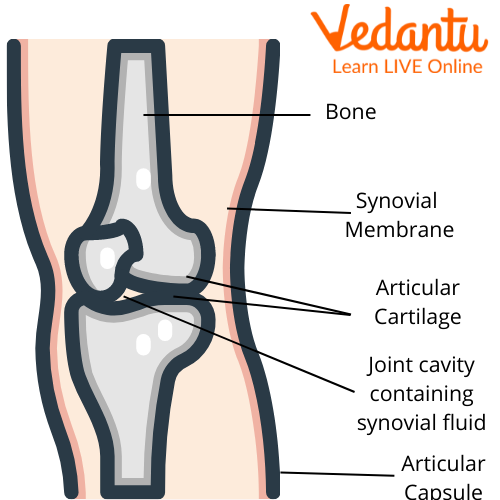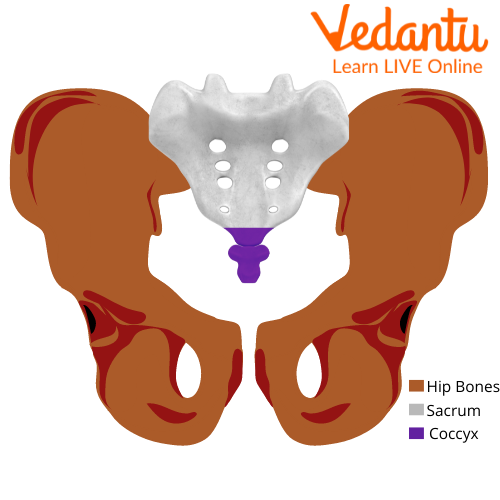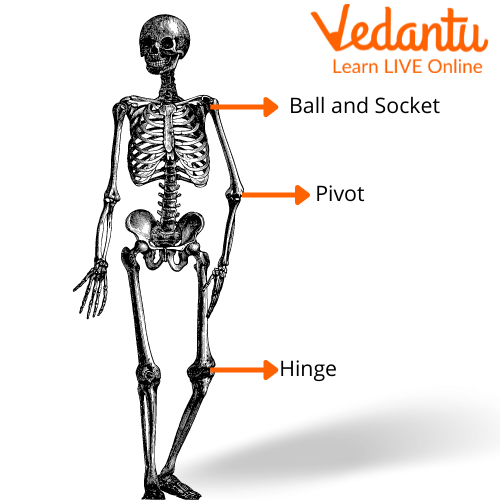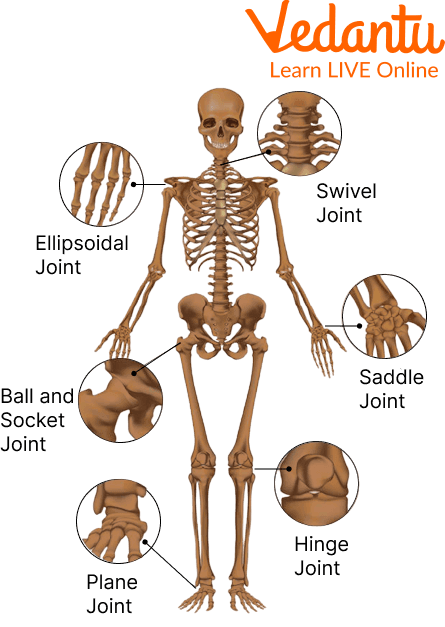




Types of Joints in Humans and How They Help Movement
Have you ever thought about what makes your body flexible? How is it that you can move, bend your knee, or hand, or turn your head? How does your body do all these activities? The answer can be understood with the help of the number of joints present in the body.
As we know, there are 360 joints in the human body. The human body is an amazing machine with 270 bones at birth, which decreases to 206 as we age as parts of our bones fuse together. Thus, there are 360 joints in our body, connecting one bone to another.
Here, we will learn about what joints are, where they are found in our body and the types of joints in the body.
What Are Joints?
Joints in the human body provide flexibility. Basically, it’s the condition of being bent. It absorbs all the forces while walking and running. Joints help to hold the skeleton together and because of this, we are able to move. For example, ball and socket joints help in movement, walking, jumping, etc.

Joints
Types of Joints in the Body
Joints can be categorised by their function of motion. There are basically three types of joints in the body on the basis of motion.
● Immovable Joints (Synarthroses) - It is basically the joints present between the first pair of sternum and ribs, and it is also the articulations between the mandible and teeth. It is also called fixed joints. Examples- articulations of bony sockets, skull sutures, and teeth in the facial skeleton.

Fixed Joints

Immovable Joint
● Slight Movement Joints (Amphiarthrosis) - The joint at some distance between the fibula, tibia, and pubic symphysis of the pelvic girdle. Examples – distal joint present between the tibia and fibula and pubic symphysis. It allows little movement for the extent of movement it needs to be diarthrosis.

The Pubic Symphysis
● Full Movement Joints (Diarthrosis) - In our body, we have bone articulations in the upper and lower limbs, here we have the best movement in terms of Joints. These are called movable joints. Examples- elbow (pivot joint), shoulder (ball and socket joint), and ankle (hinge joint) are the perfect examples.

Movable Joints
Joints By Their Structure
● Fibrous Joints – There is a thick connective tissue present in the articulations of fibrous joints which leads to a maximum of them in an immovable condition but there are some types of fibrous joints that are movable.Below given are examples of three fibrous joints.
Sutures – These types of joints basically have saw-like edges that are fixed and locked together with fibres of connective tissue. They are non-movable only because of their saw-like edges.
Gomphoses – We have fibrous articulations present between the maxilla or mandible and the teeth; they are also immovable joints.
Syndesmosis – These are the joints where only a little movement is possible; we have a ligament that connects two bones together which allows them to do a little movement. The joint between the fibula and the tibia bone is a perfect example of syndesmosis.
● Cartilaginous Joints – The joints that help to connect bones with the help of cartilage are called cartilaginous joints. Here we have two types of cartilaginous joints:
Synchronous – It is basically a non-movable cartilaginous joint present in our body, the easiest example is the first pair of ribs and sternum.
Symphysis – It is basically a type of compressible fibrocartilaginous pad which helps in connecting two bones. The hip bones joined with the pubic symphysis is a perfect example of the symphysis. It also takes us to the conclusion that these types of joints have some movement capabilities. Here we have another example that the vertebrae, connected by intervertebral discs.
● Synovial / Movable Joints
In this joint, the uppermost layer of bones is covered by an articular cartilage coating. The surrounding ligaments help by supporting the synovial joints, which helps to prevent injury by limiting movement. We have six types of synovial/movable joints present in our body. Now, the question arises:
What is the role of movable joints in the body?
The role of movable joints in our body with all six types are given below:

Movable Joints in the Human Body
Gliding Joints- These types of joints move against each other in the same (single) plane. Some examples are the bones of wrists and ankles, it also includes intervertebral joints.
Hinge Joints – These types of joints have both flexion and extension. They only need one axis to move. The perfect examples of these are elbow and finger joints.
Pivot Joints – These basically provide rotation, the atlas, and the axis from the pivot joint used in the rotation of the head.
Condyloid Joint- This type of joint helps in flexion, extension, and circular motion. A perfect example is the radius and the carpal bones in the wrist joint.
Saddle Joint – It has no rotation but it has flexion, extension, and other similar movements, the perfect example is the thumb’s saddle joint present between the metacarpal and trapezium which helps the thumb cross over the palm and makes it opposable.
Ball and Socket Joint – It might be considered the best joint because it can rotate on any axis. Examples are shoulder and hip joints.
Summary
The joints in the skeleton keep it all together. A joint, which also absorbs all the stresses produced by walking and running, provides flexion, which is essentially the state of being bent. A joint is a place where two different bones in our body meet. The number of joints present in the body of a human being is 360.
The bones are kept so firmly in place in fixed joints that they are completely immobile. Moveable joints are joints that permit motions in multiple directions. For example, movement in every direction is possible with a ball and socket. Our head can rotate to the left or the right thanks to the pivot joint.
FAQs on Joints in the Human Body: A Complete Guide
1. What is a joint in the human body?
A joint is a specific location in the body where two or more bones meet. Joints are crucial for all types of movement, providing the skeleton with the flexibility needed to bend, twist, and perform daily activities. Without joints, our bodies would be rigid and unable to move.
2. What are the main types of joints based on the movement they allow?
Based on the range of movement they permit, joints in the human body are classified into three main types:
- Immovable (Fixed) Joints: These joints, like the sutures in the skull, do not allow any movement and provide strong protection.
- Slightly Movable Joints: These allow for limited movement, such as the joints between the vertebrae in your spine.
- Freely Movable (Synovial) Joints: These allow a wide range of motion and include most joints in the body, such as the knee, shoulder, and wrist.
3. What is the main function of joints in our body?
The primary function of joints is to enable movement and provide flexibility to the skeleton. They act as pivot points where bones connect, allowing us to perform essential actions like walking, running, bending, and grasping. Joints also play a role in providing stability to the body's structure.
4. Explain a ball and socket joint with an example.
A ball and socket joint is a type of freely movable joint where the rounded, ball-like end of one bone fits into a cup-shaped socket of another. This structure allows for the greatest range of motion, including movement in all directions and rotation. The best examples in the human body are the shoulder and hip joints.
5. How does a hinge joint work and where is it found?
A hinge joint functions like a door hinge, allowing bones to move back and forth in a single plane (flexion and extension). It does not permit rotation. You can find classic examples of hinge joints in your knees and elbows, which allow you to bend and straighten your limbs.
6. What is a pivot joint? Provide an example.
A pivot joint is a type of movable joint that allows only for rotational movement. In this joint, a cylindrical bone rotates within a ring formed by another bone and a ligament. A key example is the joint in the neck between the top two vertebrae, which allows you to turn your head from side to side.
7. Why can we move our arms in circles but our knees only back and forth?
The difference in movement is due to the type of joint in each area. Your shoulder is a ball and socket joint, allowing for a wide, circular range of motion. In contrast, your knee is a hinge joint, specifically designed to allow movement in only one direction—bending and straightening—providing stability for walking and running rather than wide rotation.
8. What would happen if the bones in our skull had movable joints like our fingers?
If our skull bones were connected by movable joints, the skull would lose its most important function: protecting the brain. The skull is made of flat bones interlocked with fixed joints (sutures) to form a rigid, strong case. Movable joints would make this case weak and unstable, failing to shield the brain effectively from impact and injury.
9. How do movable joints like the knee move so smoothly without bones grinding against each other?
Movable joints achieve smooth, painless motion thanks to two important components. Firstly, the ends of the bones are covered by a smooth, tough tissue called cartilage, which acts as a shock absorber. Secondly, the joint is enclosed in a capsule containing synovial fluid, a natural lubricant that minimises friction, allowing the bones to glide past one another effortlessly.
10. What is the difference between a ligament and a tendon?
While both are crucial for movement, they have distinct roles. Ligaments are strong, elastic bands of tissue that connect bone to bone; their main job is to hold a joint together and provide stability. In contrast, tendons are tough, non-elastic cords of tissue that connect muscle to bone, transferring the force from the muscle to move the bone.









